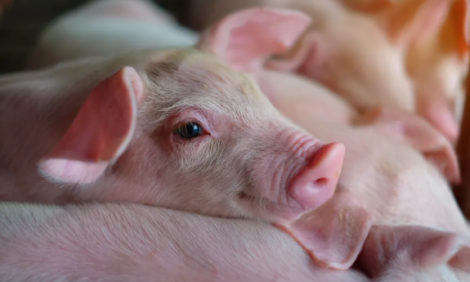



Effects of Nutrition During Gilt Development on Lifetime Productivity of Sows of Two Profile Maternal Lines
Differences in litter performance between genetic lines do not appear to be due to gilt management. Dietary energy restriction during the gilt development period positively affects litter weaning weight. By Phillip S. Miller, Rodger K. Johnson, Roman Moreno, Matthew W. Anderson, Jeffery M. Perkins, Donald R. McClure, Thomas McGargill1. Published in the Nebraska Swine Report.Summary
An experiment was conducted to determine the effects of energy restriction during the gilt development period on lifetime sow reproductive performance of two maternal lines. There were essentially no interactions among line, dietary treatment, and parity. The Large White x Landrace gilts were heavier before and after dietary treatments, matured later, and had greater longissimus muscle area compared to Nebraska Line gilts. Restricting energy intake during the developmental period increased litter weaning weight but had no affect on litter size. Nutritional management of prolific sow lines during the gilt development period does affect sow and litter performance. However, these results do not suggest that the sow populations studied should be fed differently during the gilt development period.
Introduction
A study to investigate the effects of nutrition during the developmental period on gilt growth and sow reproductive performance of two prolific maternal lines was initiated in 2005. Updates and reports have been provided in the 2006 and 2007 Nebraska Swine Report. Currently, data are being collected for the fourth parity of the three replications of the designed study. To our knowledge, this study represents the sole effort to examine effects of nutrition (dietary energy restriction) during the gilt developmental period on reproductive performance of two prolific sow lines studied over four parities.
Previous reports have highlighted the issues regarding the challenges facing swine and seedstock producers in developing gilts for inclusion into the sow herd. Although a multitude of factors affecting optimization of gilts face the swine industry, two factors (genetic background and energy intake) have been isolated in the study described herein. The reader is encouraged to review the companion article to this report (Johnson et al., 2008) for elaboration of gilt populations, dietary regimens, gilt management, and measurements.
Materials and Methods
Gilt populations
Two populations of gilts were used. One population was the progeny of UNL swine nutrition females and an industry maternal line (LM) boar and will be denoted as LW × LR. The other group was progeny of the LM boars described above and females from the Nebraska Index Line selected for increased litter size and also selected for improved carcass characteristics and growth performance during the last six generations (denoted L45).
Gilt management and dietary treatments
Gilts from both populations were similarly managed in the nursery until approximately 60 days of age (45 lb).
Gilts were penned in groups (n = 10) and received identical diets (cornsoybean meal-based) and management until 123 days of age (3-phase growing-finishing period). At this time, gilt pens were assigned to receive one of two dietary regimens; ad libitum treatment (AL) that was a corn-soybean meal diet (0.70% lysine, 0.70% Ca, 0.60% P) provided until gilts were moved into the breeding barn, or a restricted treatment (R).
The R group received a corn-soybean diet at approximately 75% of the energy intake of the AL group until moved into the breeding barn. The diet provided to the R groups contained 0.93% lysine, 1.0% Ca, and 0.80% P. The R treatment was designed to only restrict energy intake and maintain the intake of all other nutrients. An elaboration of procedures used to allocate feed to the R gilts is described in the 2007 Nebraska Swine Report, pp. 10-13 and companion report (Johnson et al., 2008 Nebraska Swine Report, pp. 21-26).
Measured traits
Beginning at approximately 123 days of age, pigs were weighed every 14 days and ultrasound measurements of 10th-rib longissimus muscle area (LMA) and backfat (BF) depth were recorded. Feeders were weighed for the determination of average daily feed intake (AL groups only). The feeding regimens were continued until pigs were moved into the breeding barn (approximately day 226).
Prior to breeding and during gestation, all gilts were fed 4 lb/day of a standard corn-soybean meal based diet (13.8% protein, 0.66% lysine) until 90 days of gestation when feed intake was increased to 5.0 lb daily. Gilts were housed in pens until inseminated and then moved into gestation stalls.
At approximately 110 days of gestation, females were placed in farrowing crates and fed 6 lb/day of a corn-soybean meal based lactation diet (18.5% protein, 1.0% lysine) until farrowing; thereafter, feed intake was increased daily for three days and then ad libitum access to feed was provided until weaning. Litters were weighed and weaned at an average age of approximately 17 days postfarrowing.
After weaning, sows were moved to the breeding area, remated and evaluated until their fourth parity.
Statistical analyses
Body weight and composition data were analyzed with a model that included line, gilt development regimen and their interaction. Replication and pen were considered random effects and pen was considered the experimental unit. Total pigs born and number of pigs born alive were analyzed with replication, line, dietary treatment, parity, and random effect of sow fitted to the model. Some crossfostering occurred, so in addition to the aforementioned effects, number of pigs weaned and litter weaning weight were adjusted for the number of pigs nursed and litter weaning age. See Johnson et al., 2008 Nebraska Swine Report, pp. 21-26 for additional details regarding statistical analyses.
Results and Discussion
It should be noted that the analysis presented herein presents means pooled among treatments. These traits are interpreted as if all sows were given an opportunity to raise the same number of pigs for the same length of time.
As noted in the companion paper and identified in this report, the number of gilts/sows varied among population/dietary treatment/parity. Also, the results of the companion paper suggest that lifetime productivity may differ according to genetic line, dietary treatment and/or parity without necessarily affecting pooled mean responses at any parity (presented herein). The number of gilts at the beginning and end of the developmental period, and the number of litters at each parity are presented in Table 1.

aAge at puberty measurement.
bAd libitum group.
cRestricted to 75% of the AL group.
Body weight (BW) , BF, LMA, and age at puberty results are presented in Table 2. The LW × LR gilts were heavier (P < 0.001) than L45 gilts at day 123 (157.8 vs. 145.1 lb) and at the end of the feeding period (288.8 vs. 272.3 lb). Dietary energy restriction compared to the AL treatment resulted in 46 lb reduction (P < 0.001) in day 226 BW. At the end of the feeding period there was no difference in BF between genetic lines (0.98 in); however, BF was reduced (P < 0.001) 33% in R vs. AL gilts. Longissimus muscle area was greater (P = 0.005) in LW × LR compared to L45 gilts (6.31 vs. 6.00 in2) at the end of the feeding period. Energy restriction during the developmental period (R vs. AL gilts) decreased (P < 0.001) LMA (6.59 vs. 5.79 in2).

aStandard error of the mean.
bEnd of the feeding period.
Total pigs born and number born alive were not affected by genetic line, dietary treatment, or parity (Table 3).

aStandard error of the mean.
There was a trend (P = 0.073) for sows that received a restricted energy intake during the developmental period to wean more pigs (9.78 vs. 9.56). Parity affected (P = 0.010) number of pigs weaned (9.64, 9.99, 9.63, and 9.25 for Parity 1, 2, 3, and 4, respectively). The LW × LR sows weaned heavier (P = 0.007) litters compared to the L45 gilts (118.8 lb vs. 111.3 lb). Energy restriction during the developmental period resulted in sows that had heavier litters at weaning (AL = 111.9 lb, R = 118.1 lb ). Parity affected (P < 0.001) litter weaning weight. Litter weaning weight was greatest at Parity 2 and least at Parity 1.
There were essentially no interactions among line, dietary treatment, and parity. The LW × LR gilts were heavier before and after the initiation of dietary treatments, matured later, and had greater LMA compared to L45 gilts. Restricting energy intake during the developmental period increased litter weaning weight.
Because sow weight and body condition (backfat) at farrowing and weaning were similar between genetic lines and dietary treatments (data presented in the companion article), the differences observed in litter weaning weight do not appear to be related to these traits. We did not measure feed intake during lactation, but changes in lactational feed intake could affect litter performance. Although the L45 sows were derived from the Nebraska line selected for increased litter size, total number of pigs born per litter was not different between lines. Likewise, milk production appears to be decreased in the L45 vs. LW × LR sows, but again, the physiological and/or nutritional basis for the difference is currently unknown . It should be noted that the maternal lines were not directly evaluated and were crossed with an unrelated industry maternal line boar to produce the two populations of females used in this study.
Footnote
1Phillip S. Miller and Rodger K. Johnson are professors in the Animal Science Department; Roman Moreno is graduate student and research technologist in the Animal Science Department; Matthew W. Anderson is manager of the UNL Swine Research Farm; Jeffrey M. Perkins, Donald R. McClure and Thomas E. McGargill are research technicians at the UNL Swine Research Farm.
Further Reading
| - | You can view the full report by clicking here. |
| Go to other articles from the Nebraska Swine Report 2008 by clicking here. |
March 2008








